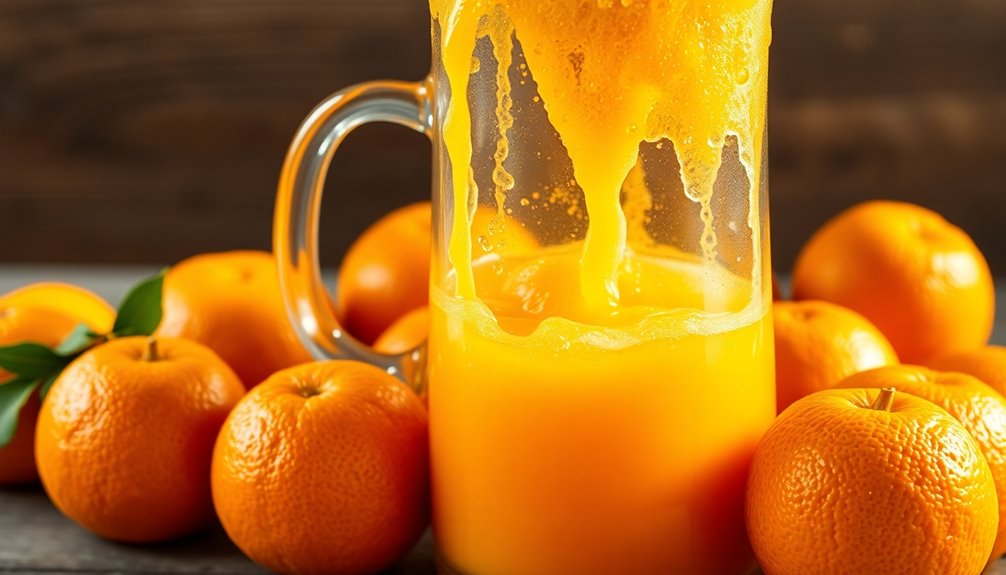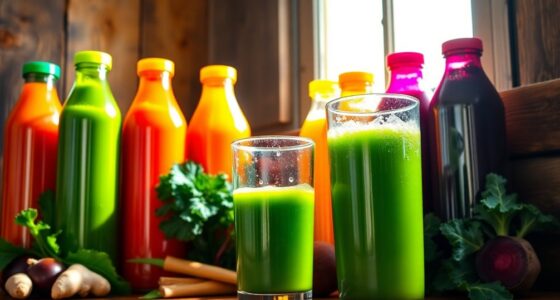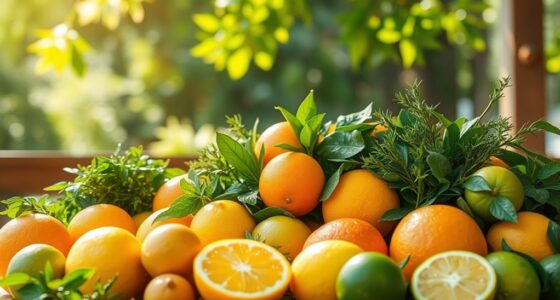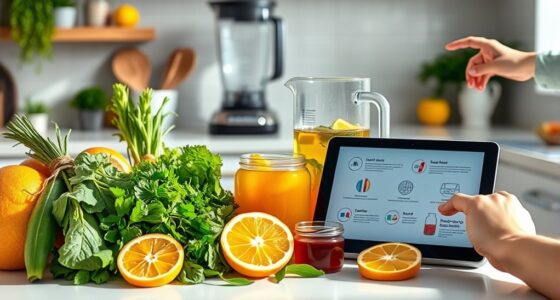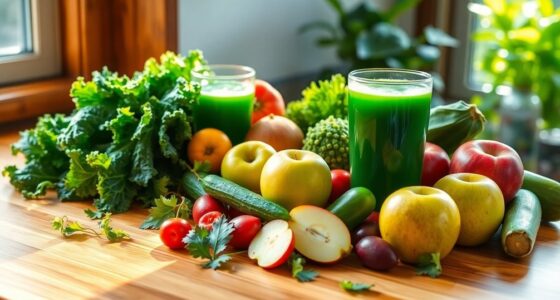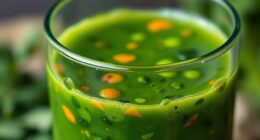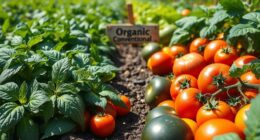To make a gallon of fresh orange juice, you'll need about 13 pounds of oranges. That's a lot of fruit! Generally, three oranges yield one cup of juice, so you can imagine how many it takes to reach a gallon. The type of orange you choose really matters too, as different varieties yield varying amounts of juice. If you're curious about which oranges make the best juice and more of the juicing process, keep exploring!
Key Takeaways
- Approximately 13 pounds of oranges are needed to produce one gallon of orange juice.
- On average, it takes about 50 to 65 oranges to make a gallon of juice.
- Juice extraction efficiency can affect the number of oranges required for a gallon.
- Seasonal factors influence the availability and cost of oranges used for juicing.
- Producing a gallon of orange juice consumes around 11.8 gallons of water.
The Basics of Orange Juice Production
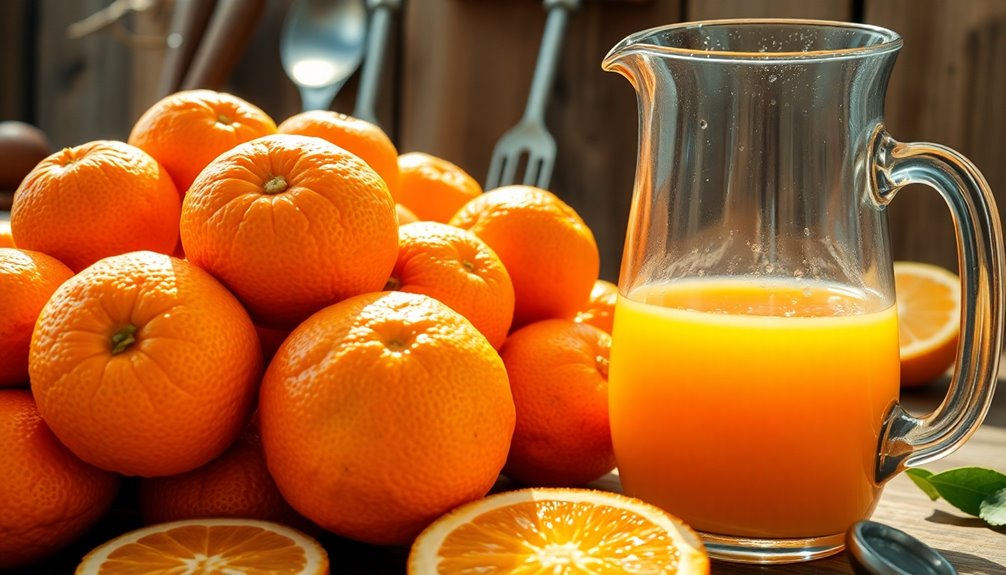
When you think about orange juice production, it's essential to understand the different types available, such as frozen concentrated and not-from-concentrate (NFC) varieties.
The manufacturing process starts with selecting, washing, and juicing the oranges, ensuring quality testing throughout. One cup (250 ml) of orange juice provides 88% water content, which contributes to its refreshing taste and hydration properties. Hydration properties are crucial for maintaining overall health and wellness.
For concentrated juice, after extraction, they heat it to inactivate spoilage-causing enzymes and reduce water content in a vacuum evaporator.
In contrast, NFC juice involves careful selection based on flavor and acidity, followed by juicing and pasteurization to maintain stability.
Both types have environmental impacts, notably in water usage and carbon emissions.
Despite a decrease in market share, orange juice remains a popular beverage choice, reflecting its enduring appeal in the beverage landscape.
How Much Juice Does One Orange Produce?
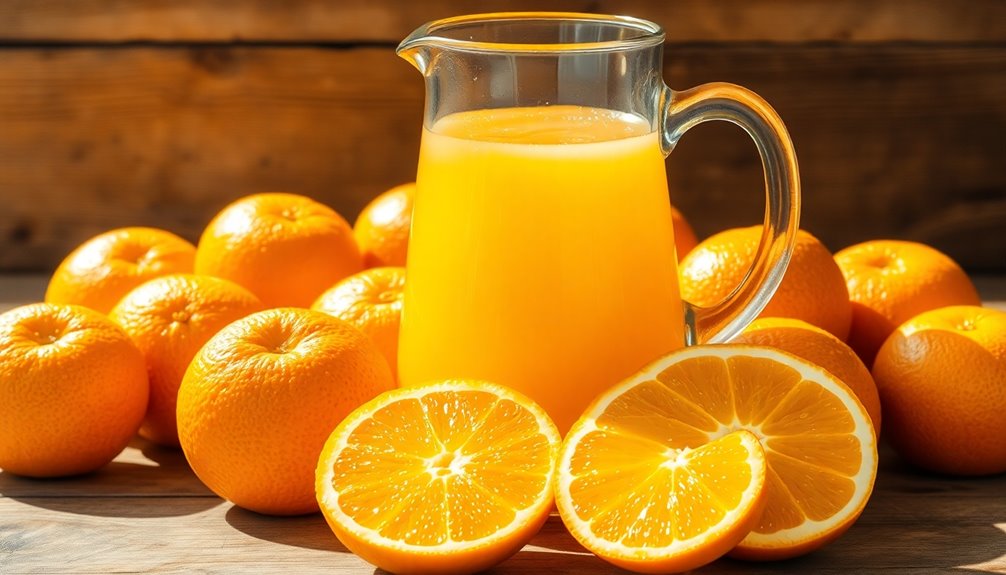
Ever wondered how much juice you can expect from a single orange? Typically, one orange yields about 4 to 5 tablespoons of juice, which is roughly 1/4 to 1/3 cup. Keep in mind that this amount can vary based on the orange's ripeness, size, and variety. For instance, a larger Valencia orange might produce more juice than a smaller navel orange. On average, you'll need about three oranges to make one cup of fresh juice. If you're squeezing oranges, remember that 1/4 of an orange gives you about 1 tablespoon of juice. Interestingly, one pound of oranges yields typically equals 2 medium-sized fruits (8 to 10 tablespoons).
Calculating Oranges Needed for a Gallon
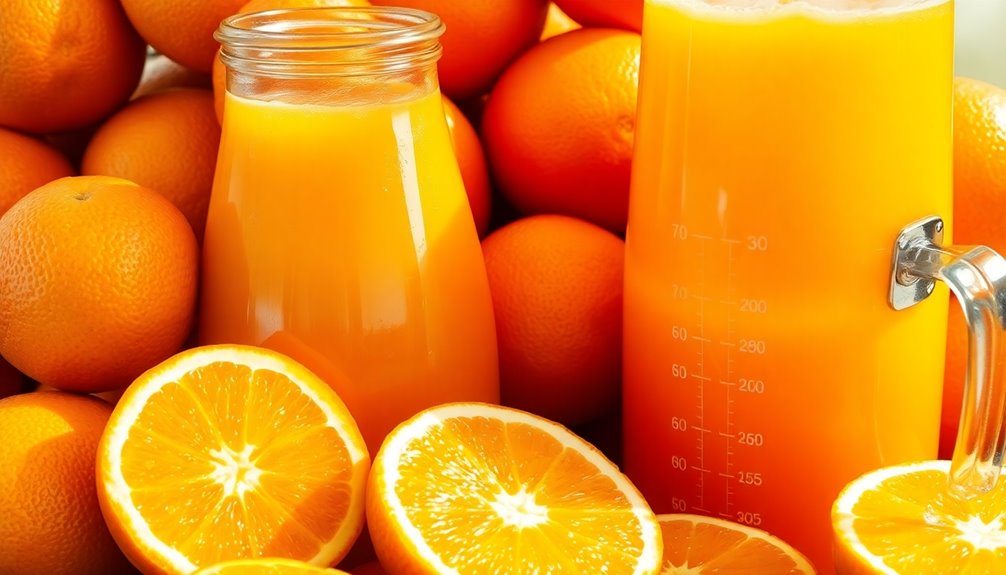
To make one gallon of orange juice, you'll need about 13 pounds of oranges. However, keep in mind that the weight can vary significantly depending on the orange variety and growing conditions. The efficiency of juice extraction also plays a crucial role in determining how many oranges you'll actually need. Seasonal factors can impact the availability and cost of oranges, as they're typically in season from October through May. Additionally, remember that producing one gallon of orange juice requires around 11.8 gallons of water, adding to the overall environmental impact. Interestingly, to create a balanced mixture of orange juice concentrations, you would need to mix different types of juices, such as 70% and 10% orange juice.
The Most Juicy Orange Varieties

Several orange varieties stand out for their juiciness, making them perfect for fresh-squeezed juice.
Valencia oranges, available year-round, offer a sweet and slightly tangy flavor, peaking in spring. Florida oranges are known for their exceptional juicing qualities, making them a top choice for juice enthusiasts. These oranges are also high in antioxidants, aiding in metabolism and fat burning.
Blood oranges, in season from January to April, boast a unique tartness and rich antioxidants that enhance any juice.
Cara Cara oranges, with their sweet-tart profile and pink flesh, are a delightful addition, available year-round but peaking in winter.
Finally, Hamlin oranges, harvested from October to November, are sweet and juicy, ideal for commercial juice production.
Each of these varieties brings a distinct taste and health benefits, ensuring your juice isn't only delicious but also nutritious. Choose your favorites to elevate your juicing experience!
Industrial Production Techniques
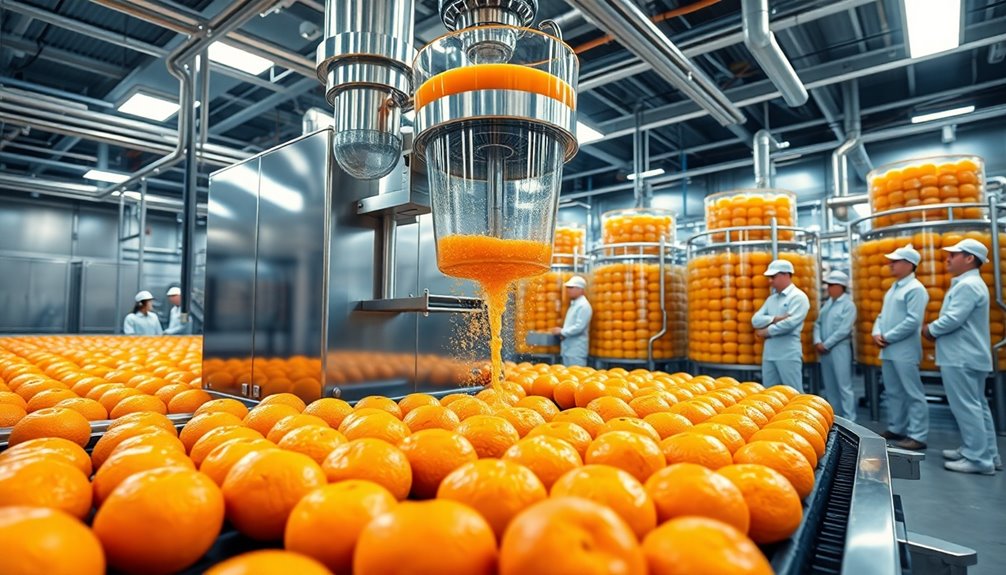
While selecting the juiciest orange varieties is important for a great glass of juice, the industrial production techniques used to process these fruits play a significant role in delivering a consistent, high-quality product.
It all starts with sorting the oranges using a roller-type machine to eliminate damaged ones. Once sorted, they're washed in soapy water and dried. After inspection, machines like in-line juicers extract the juice, carefully avoiding the bitter peel and seeds. To ensure quality during storage, regular checks for quality are conducted throughout the entire process. Additionally, the use of Merkle trees in the tracking of juice production can enhance data integrity and improve overall efficiency.
The juice is then filtered to remove pulp and concentrated to enhance flavor and shelf life. Finally, it's reconstituted with water and additives, packaged, and shipped in refrigerated vehicles to ensure that fresh taste reaches your glass every time.
Factors Influencing Juice Yield
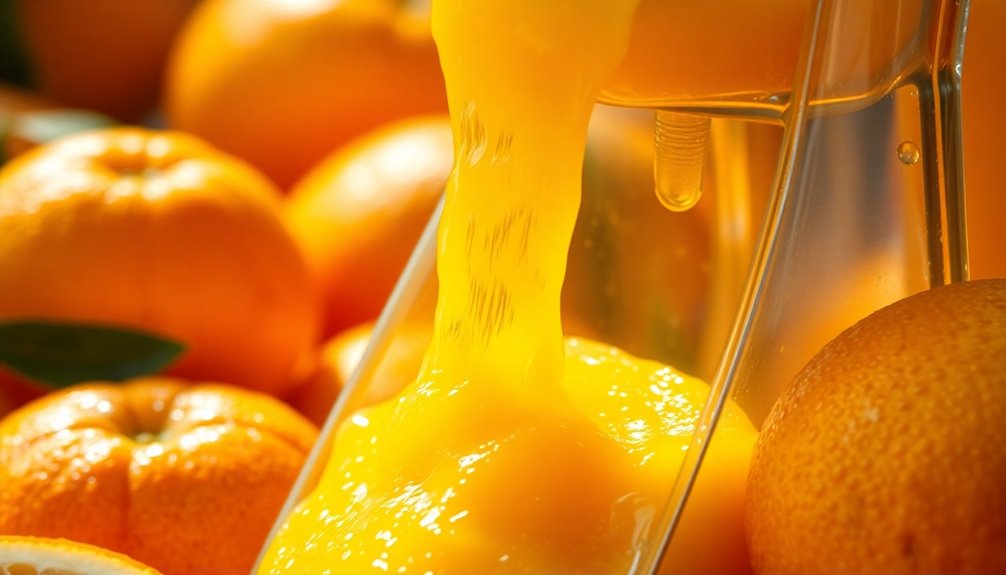
When it comes to extracting juice from oranges, various factors come into play that can significantly influence the yield you get.
First, the characteristics of the fruit matter—ripeness, moisture content, and size all play a crucial role. Riper oranges, for instance, contain more liquid and yield better juice. Additionally, understanding how to calculate juice yield can help you assess the efficiency of your extraction process. The soluble fiber found in other fruits can also affect the overall juicing experience.
The extraction method you choose also impacts the outcome; techniques like cold-pressing can maximize juice yield compared to manual methods.
Additionally, proper handling and preparation of the fruit, such as washing and removing seeds, can enhance efficiency.
Lastly, environmental aspects like seasonality and climate affect the fruit's quality, which ultimately determines how much juice you can extract.
Pay attention to these factors for the best results!
Economic and Environmental Considerations
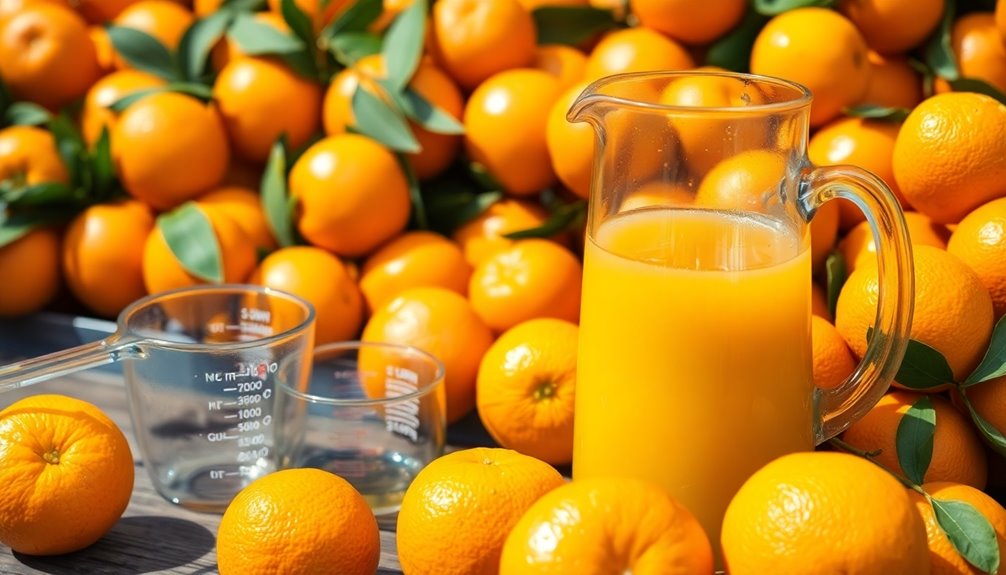
Understanding the economic and environmental considerations surrounding orange juice production is essential for both consumers and producers alike. The demand for orange juice is shaped by consumer preferences and the economy, while production costs include labor, fertilizers, and equipment. Researching current industry reports can provide insights into the factors influencing these costs.
Price fluctuations occur due to supply and demand, weather, and global trends, impacting industry employment in agriculture and processing.
On the environmental side, orange juice production contributes to greenhouse gas emissions, high water usage, and biodiversity loss. Fertilizers and pesticides can harm soil health and water quality.
Moreover, packaging and transportation add to the carbon footprint. Embracing sustainable practices, like organic farming and energy-efficient processing, can mitigate these impacts, promoting a healthier industry for everyone involved.
Frequently Asked Questions
What Are the Health Benefits of Drinking Orange Juice?
Drinking orange juice offers numerous health benefits.
It's packed with vitamin C, boosting your immune system and helping fight infections. The potassium content supports heart health by regulating blood pressure.
With its antioxidants, orange juice reduces inflammation and protects against chronic diseases. Additionally, it aids digestion and may prevent kidney stones.
Regularly enjoying this refreshing beverage can enhance your overall health, providing essential nutrients your body needs to thrive.
How Should Orange Juice Be Stored for Freshness?
You've got fresh orange juice, but how do you keep it that way?
While room temperature spoils it in just two hours, proper refrigeration extends its life to 2-3 days. Use airtight containers to minimize air exposure, and keep them out of light.
For long-term storage, freeze it in portions, but remember to leave space for expansion.
Label containers with dates to ensure you enjoy every drop at its freshest!
Can Orange Juice Be Made From Frozen Oranges?
Yes, you can make orange juice from frozen oranges! Just remember to thaw them first, as this helps extract the juice effectively.
While fresh oranges typically yield more juice, frozen ones can still produce a tasty beverage if handled properly.
Ensure you maintain quality control during processing to get the best flavor and nutritional value.
What Is the Best Time to Harvest Oranges for Juicing?
When's the best time to harvest oranges for juicing? Imagine savoring the freshest juice, bursting with flavor—this is achievable when you pick oranges at their peak.
Generally, you'll find the sweetest fruit from October to May. During this period, varieties like Washington Navel shine.
Keep in mind that local climate and tree health can affect ripeness, so always check for firmness, weight, and that irresistible citrus aroma before you harvest.
Are There Any Additives in Commercially Produced Orange Juice?
Yes, there are additives in commercially produced orange juice.
You'll often find ethyl butyrate for enhancing flavor, along with citric and ascorbic acids to boost acidity and vitamin C content.
Flavor packs, which restore taste post-processing, aren't always listed on labels.
Some brands also add vitamins like D and calcium, plus omega-3 fatty acids for extra nutrition.
These additives help maintain flavor and nutritional value, especially after pasteurization and concentration.
Conclusion
Now you know how many oranges it takes to make a gallon of juice, you can appreciate the effort behind your morning glass. You’ve learned about the varieties that pack the most punch, the methods that maximize yield, and the factors that can influence juice production. So next time you sip that fresh juice, remember the journey it took—from the orchard to your table, from the fruit to the flavor, and from the tree to your taste buds. As you savor that vibrant glass of juice, you might also find yourself curious about its other uses. For instance, you may wonder how much alcohol in orange juice can enhance a cocktail or brunch experience, creating delightful blends that elevate your gatherings. Whether enjoyed in its pure form or as part of a creative concoction, each sip of orange juice tells a story of its own.
Susannah expertise lies in researching and compiling evidence-based content on juicing, nutrition, and overall health. She is committed to ensuring that The Juicery World offers accurate, up-to-date, and trustworthy information to empower readers to take control of their health. Susannah’s goal is to inspire individuals to embrace juicing as a way to nourish their bodies and live their best lives.

